Agriculture
The major recognizable life zones of the continents are divided into biomes, characterized by their plant communities.
Temperature, precipitation, soil, and length of day affect the survival and distribution of biome species. Species diversity within a biome may increase its stability and capability to deliver natural services, including enhancing the quality of the atmosphere, forming and protecting the soil, controlling pests, and providing clean water, fuel, food, and drugs. Major biomes include the temperate, tropical, and boreal forests; tundra; deserts; grasslands; chaparral; and oceans.
Temperate Forests
The temperate forest biome occupies the so called temperate zones in the midlatitudes (from about 30 to 60 degrees north and south of the equator). Temperate forests are found mainly in Europe, eastern North America, and eastern China, and in narrow zones on the coasts of Australia, New Zealand, Tasmania, and the Pacific coasts of North and South America. Their climates are characterized by high rainfall and temperatures that vary from cold to mild.
Temperate forests contain primarily deciduous trees?including maple, oak, hickory, and beech-wood?and, secondarily, evergreen trees?including pine, spruce, fir, and hemlock. Evergreen forests in some parts of the Southern Hemisphere contain eucalyptus trees. The root systems of forest trees help keep the soil rich. The soil quality and color are due to the action of earthworms.
Where these forests are frequently logged, soil runoff pollutes streams, which reduces spawning habitat for fish. Raccoons, opossums, bats, and squirrels are found in the trees. Deer and black bears roam forest floors. During winter, small animals such as marmots and squirrels burrow in the ground.
Tropical Forests
Tropical forests exist in frost-free areas between the Tropic of Cancer and the Tropic of Capricorn. Temperatures range from warm to hot year-round. These forests are found in northern Australia, the East Indies, Southeast Asia, equatorial Africa, and parts of Central America and northern South America.
Tropical forests have high biological diversity and contain about 15 percent of the world?s plant species. Animal life thrives at each layer of tropical forests. Nuts and fruits on the trees provide food for birds, monkeys, squirrels, and bats. Monkeys and sloths feed on tree leaves.
Roots, seeds, leaves, and fruit on the forest floor feed larger animals. Tropical forest trees produce rubber and hardwood, such as mahogany and rosewood. Deforestation for agriculture and pastures has caused reduction in plant and animal diversity in these forests.
Boreal Forests
The boreal forest is a circumpolar Northern Hemisphere biome spread across Russia, Scandinavia, Canada, and Alaska. The region is very cold. Evergreen trees such as white spruce and black spruce dominate this zone, which also contains larch, balsam, pine, fir, and some deciduous hardwoods such as birch and aspen. The acidic needles from the evergreens make the leaf litter that is changed into soil humus. The acidic soil limits the plants that develop.
Animals in boreal forests include deer, bears, and wolves. Birds in this zone include red-tailed hawks, sapsuckers, grouse, and nuthatches. Relatively few animals emigrate from this habitat during winter. Conifer seeds are the basic winter food.
Tundra
About 5 percent of the earth?s surface is covered with Arctic tundra and 3 percent with alpine tundra. The Arctic tundra is the area of Europe, Asia, and North America north of the boreal coniferous forest zone, where the soils remain frozen most of the year.
Arctic tundra has a permanent frozen subsoil, called permafrost. Deep snow and low temperatures slow the soil-forming process. The area is bounded by a 50 degrees Fahrenheit (122 degrees Celsius) circumpolar isotherm, known as the summer isotherm. The cold temperature north of this line prevents normal tree growth.
The tundra landscape is covered by mosses, lichens, and low shrubs, which are eaten by caribou, reindeer, and musk oxen. Wolves eat these herbivores. Bears, foxes, and lemmings also live there. The most common Arctic bird is the old squaw duck. Ptarmigans and eider ducks are also very common. Geese, falcons, and loons are some of the nesting birds of the area.
The alpine tundra, which exists at high altitude in all latitudes, is acted upon by winds, cold temperatures, and snow. The plant growth is mostly cushion- and mat-forming plants.
Deserts
The desert biome covers about one-seventh of the earth?s surface. Deserts typically receive no more than 10 inches (25 centimeters) of rainfall per year, and evaporation generally exceeds rainfall. Deserts are found around the Tropic of Cancer and the Tropic of Capricorn.
As warm air rises over the equator, it cools and loses its water content. The dry air descends in the two subtropical zones on each side of the equator; as it warms, it picks up moisture, resulting in drying the land.
Rainfall is a key agent in shaping the desert. The lack of sufficient plant cover contributes to soil erosion during wind- and rainstorms. Some desert plants?for example, the mesquite tree, which has roots that grow 40 feet (13 meters) deep?obtain water from deep below the earth?s surface.
Other plants, such as the barrel cactus, store large amounts of water in their leaves, roots, or stems. Some plants slow the loss of water by having tiny leaves or shedding their leaves. Desert plants have very short growth periods, because they cannot grow during the long drought periods.
Grasslands
Grasslands cover about one-quarter of the earth?s surface and can be found between forests and deserts. Treeless grasslands exist in parts of central North America, Central America, and eastern South America that have between 10 and 40 inches (250-1,000millimeters) of erratic rainfall per year. The climate has a high rate of evaporation and periodic major droughts. Grasslands are subject to fire.
Some grassland plants survive droughts by growing deep roots, while others survive by being dormant. Grass seeds feed the lizards and rodents that become the food for hawks and eagles. Large animals in this biome include bison, coyotes, mule deer, and wolves.
The grasslands produce more food than any other biome. Overgrazing, inefficient agricultural practices, and mining destroy the natural stability and fertility of these lands, resulting in reduced carrying capacity,water pollution, and soil erosion.
Diverse natural grasslands appear to be more capable of surviving drought than are simplified manipulated grass systems. This may be due to slower soil mineralization and nitrogen turnover of plant residues in the simplified system.
Savannas are open grasslands containing deciduous trees and shrubs. They are near the equator and are associated with deserts. Grasses there grow in clumps and do not form a continuous layer.
Chaparral
The chaparral, or mediterranean, biome is found in the Mediterranean Basin, California, parts of Australia, middle Chile, and the Cape Province of South America. This region has a climate of wet winters and summer drought. The plants have tough, leathery leaves and may have thorns. Regional fires clear the area of dense and dead vegetation.
The seeds from some plants, such as the California manzanita and South African fire lily, are protected by the soil during a fire and later germinate and rapidly grow to form new plants. Vegetation dwarfing occurs as a result of the severe summer drought and extreme climate changes.
Oceans
The ocean biome covers more than 70 percent of the earth?s surface and includes 90 percent of its volume.Oceans have four zones. The intertidal zone is shallow and lies at the land?s edge. The continental shelf, which begins where the intertidal zone ends, is a plain that slopes gently seaward.
The neritic zone (continental slope) begins at a depth of about 600 feet (180 meters), where the gradual slant of the continental shelf becomes a sharp tilt toward the ocean floor, plunging about 12,000 feet (3,660 meters) to the ocean bottom, which is known as the abyss. The abyssal zone is so deep that it does not have light.
Plankton are animals that float in the ocean. They include algae and copepods, which are microscopic crustaceans. Jellyfish and animal larva are also considered plankton. The nekton are animals that move freely through the water by means of their muscles.
These include fish, whales, and squid. The benthos are animals that are attached to or crawl along the ocean?s floor. Clams are examples of benthos. Bacteria decompose the dead organic materials on the ocean floor.
The circulation of materials from the ocean?s floor to the surface is caused by winds and water temperature. Runoff from the land contains pollutants such as pesticides, nitrogen fertilizers, and animal wastes. Rivers carry loose soil to the ocean, where it builds up the bottom areas. Overfishing has caused fisheries to collapse in every world sector.
Human Impact on Biomes
Human interaction with biomes has increased biological invasions, reduced species biodiversity, changed the quality of land and water resources, and caused the proliferation of toxic compounds. Managed care of biomes may not be capable of undoing these problems.
- Central American Flora
Central American FloraCentral America ? comprising the nations Belize, Costa Rica, El salvador, Guatemala, Honduras, Nicaragua, and Panama ? is a land bridge that connects North America and South America, and many of its plants are similar to plants found...
- Savannas And Deciduous Tropical Forests
Savannas are areas of continuous grass or sedge cover beneath trees that range from scattered, twisted, and gnarled individuals to open wood lands. Deciduous tropical forests have continuous to open forest cover and undergo a leafless period during a...
- South American Flora
South American FloraSouth America is the most diverse continent in terms of flora, primarily because of its location and geography. South America?s floristic diversity is increased by its high mountains, especially the Andes Mountains, which extend from...
- Taiga
Taiga in Findland ?Taiga? derives from a Russian word for the forests of cone-bearing, needle-leaved, generally evergreen trees of northern Eurasia and North America. ?Coniferous forest? and ?boreal forest? are other names given to this biome. Some botanists...
- Tundra And High-altitude Biomes
Tundra and High-Altitude BiomesRegions where no trees grow because of frozen soil or extreme water runoff due to steep grades (at high altitudes) are known as tundra. High altitude biomes have similar limitations on the growth of plant life. Tundra landscapes...
Agriculture
Types of Biomes
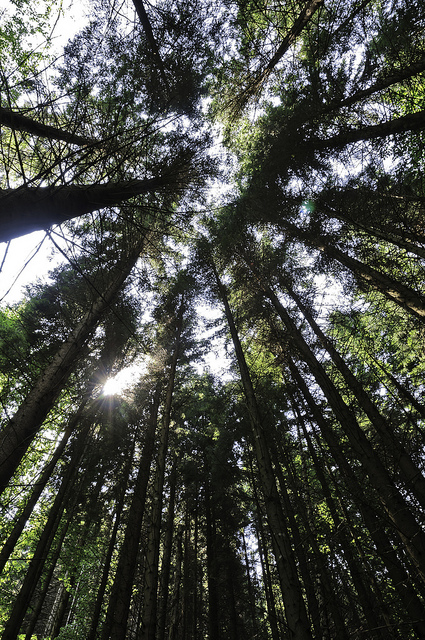 |
| Types of Biomes |
The major recognizable life zones of the continents are divided into biomes, characterized by their plant communities.
Temperature, precipitation, soil, and length of day affect the survival and distribution of biome species. Species diversity within a biome may increase its stability and capability to deliver natural services, including enhancing the quality of the atmosphere, forming and protecting the soil, controlling pests, and providing clean water, fuel, food, and drugs. Major biomes include the temperate, tropical, and boreal forests; tundra; deserts; grasslands; chaparral; and oceans.
Temperate Forests
The temperate forest biome occupies the so called temperate zones in the midlatitudes (from about 30 to 60 degrees north and south of the equator). Temperate forests are found mainly in Europe, eastern North America, and eastern China, and in narrow zones on the coasts of Australia, New Zealand, Tasmania, and the Pacific coasts of North and South America. Their climates are characterized by high rainfall and temperatures that vary from cold to mild.
Temperate forests contain primarily deciduous trees?including maple, oak, hickory, and beech-wood?and, secondarily, evergreen trees?including pine, spruce, fir, and hemlock. Evergreen forests in some parts of the Southern Hemisphere contain eucalyptus trees. The root systems of forest trees help keep the soil rich. The soil quality and color are due to the action of earthworms.
Where these forests are frequently logged, soil runoff pollutes streams, which reduces spawning habitat for fish. Raccoons, opossums, bats, and squirrels are found in the trees. Deer and black bears roam forest floors. During winter, small animals such as marmots and squirrels burrow in the ground.
Tropical Forests
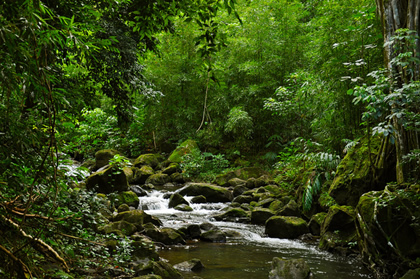 |
| Tropical Forests |
Tropical forests exist in frost-free areas between the Tropic of Cancer and the Tropic of Capricorn. Temperatures range from warm to hot year-round. These forests are found in northern Australia, the East Indies, Southeast Asia, equatorial Africa, and parts of Central America and northern South America.
Tropical forests have high biological diversity and contain about 15 percent of the world?s plant species. Animal life thrives at each layer of tropical forests. Nuts and fruits on the trees provide food for birds, monkeys, squirrels, and bats. Monkeys and sloths feed on tree leaves.
Roots, seeds, leaves, and fruit on the forest floor feed larger animals. Tropical forest trees produce rubber and hardwood, such as mahogany and rosewood. Deforestation for agriculture and pastures has caused reduction in plant and animal diversity in these forests.
Boreal Forests
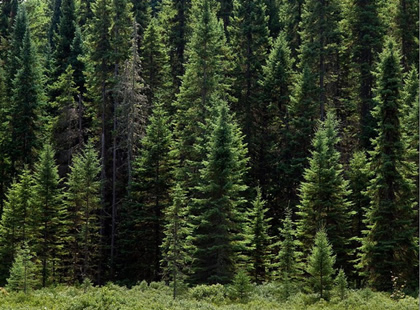 |
| Boreal Forests |
The boreal forest is a circumpolar Northern Hemisphere biome spread across Russia, Scandinavia, Canada, and Alaska. The region is very cold. Evergreen trees such as white spruce and black spruce dominate this zone, which also contains larch, balsam, pine, fir, and some deciduous hardwoods such as birch and aspen. The acidic needles from the evergreens make the leaf litter that is changed into soil humus. The acidic soil limits the plants that develop.
Animals in boreal forests include deer, bears, and wolves. Birds in this zone include red-tailed hawks, sapsuckers, grouse, and nuthatches. Relatively few animals emigrate from this habitat during winter. Conifer seeds are the basic winter food.
Tundra
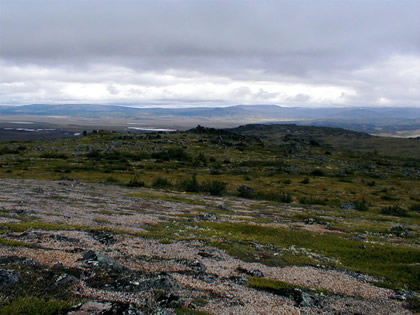 |
| Tundra |
About 5 percent of the earth?s surface is covered with Arctic tundra and 3 percent with alpine tundra. The Arctic tundra is the area of Europe, Asia, and North America north of the boreal coniferous forest zone, where the soils remain frozen most of the year.
Arctic tundra has a permanent frozen subsoil, called permafrost. Deep snow and low temperatures slow the soil-forming process. The area is bounded by a 50 degrees Fahrenheit (122 degrees Celsius) circumpolar isotherm, known as the summer isotherm. The cold temperature north of this line prevents normal tree growth.
The tundra landscape is covered by mosses, lichens, and low shrubs, which are eaten by caribou, reindeer, and musk oxen. Wolves eat these herbivores. Bears, foxes, and lemmings also live there. The most common Arctic bird is the old squaw duck. Ptarmigans and eider ducks are also very common. Geese, falcons, and loons are some of the nesting birds of the area.
The alpine tundra, which exists at high altitude in all latitudes, is acted upon by winds, cold temperatures, and snow. The plant growth is mostly cushion- and mat-forming plants.
Deserts
 |
| Deserts |
The desert biome covers about one-seventh of the earth?s surface. Deserts typically receive no more than 10 inches (25 centimeters) of rainfall per year, and evaporation generally exceeds rainfall. Deserts are found around the Tropic of Cancer and the Tropic of Capricorn.
As warm air rises over the equator, it cools and loses its water content. The dry air descends in the two subtropical zones on each side of the equator; as it warms, it picks up moisture, resulting in drying the land.
Rainfall is a key agent in shaping the desert. The lack of sufficient plant cover contributes to soil erosion during wind- and rainstorms. Some desert plants?for example, the mesquite tree, which has roots that grow 40 feet (13 meters) deep?obtain water from deep below the earth?s surface.
Other plants, such as the barrel cactus, store large amounts of water in their leaves, roots, or stems. Some plants slow the loss of water by having tiny leaves or shedding their leaves. Desert plants have very short growth periods, because they cannot grow during the long drought periods.
Grasslands
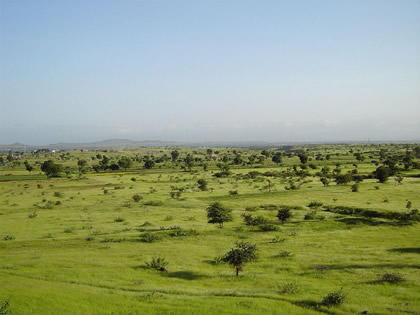 |
| Grasslands |
Grasslands cover about one-quarter of the earth?s surface and can be found between forests and deserts. Treeless grasslands exist in parts of central North America, Central America, and eastern South America that have between 10 and 40 inches (250-1,000millimeters) of erratic rainfall per year. The climate has a high rate of evaporation and periodic major droughts. Grasslands are subject to fire.
Some grassland plants survive droughts by growing deep roots, while others survive by being dormant. Grass seeds feed the lizards and rodents that become the food for hawks and eagles. Large animals in this biome include bison, coyotes, mule deer, and wolves.
The grasslands produce more food than any other biome. Overgrazing, inefficient agricultural practices, and mining destroy the natural stability and fertility of these lands, resulting in reduced carrying capacity,water pollution, and soil erosion.
Diverse natural grasslands appear to be more capable of surviving drought than are simplified manipulated grass systems. This may be due to slower soil mineralization and nitrogen turnover of plant residues in the simplified system.
Savannas are open grasslands containing deciduous trees and shrubs. They are near the equator and are associated with deserts. Grasses there grow in clumps and do not form a continuous layer.
Chaparral
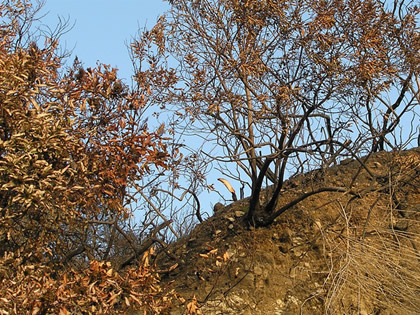 |
| Chaparral |
The chaparral, or mediterranean, biome is found in the Mediterranean Basin, California, parts of Australia, middle Chile, and the Cape Province of South America. This region has a climate of wet winters and summer drought. The plants have tough, leathery leaves and may have thorns. Regional fires clear the area of dense and dead vegetation.
The seeds from some plants, such as the California manzanita and South African fire lily, are protected by the soil during a fire and later germinate and rapidly grow to form new plants. Vegetation dwarfing occurs as a result of the severe summer drought and extreme climate changes.
Oceans
The ocean biome covers more than 70 percent of the earth?s surface and includes 90 percent of its volume.Oceans have four zones. The intertidal zone is shallow and lies at the land?s edge. The continental shelf, which begins where the intertidal zone ends, is a plain that slopes gently seaward.
The neritic zone (continental slope) begins at a depth of about 600 feet (180 meters), where the gradual slant of the continental shelf becomes a sharp tilt toward the ocean floor, plunging about 12,000 feet (3,660 meters) to the ocean bottom, which is known as the abyss. The abyssal zone is so deep that it does not have light.
 |
| Easy DIY Aquaponics |
These include fish, whales, and squid. The benthos are animals that are attached to or crawl along the ocean?s floor. Clams are examples of benthos. Bacteria decompose the dead organic materials on the ocean floor.
The circulation of materials from the ocean?s floor to the surface is caused by winds and water temperature. Runoff from the land contains pollutants such as pesticides, nitrogen fertilizers, and animal wastes. Rivers carry loose soil to the ocean, where it builds up the bottom areas. Overfishing has caused fisheries to collapse in every world sector.
Human Impact on Biomes
Human interaction with biomes has increased biological invasions, reduced species biodiversity, changed the quality of land and water resources, and caused the proliferation of toxic compounds. Managed care of biomes may not be capable of undoing these problems.
- Central American Flora
Central American FloraCentral America ? comprising the nations Belize, Costa Rica, El salvador, Guatemala, Honduras, Nicaragua, and Panama ? is a land bridge that connects North America and South America, and many of its plants are similar to plants found...
- Savannas And Deciduous Tropical Forests
Savannas are areas of continuous grass or sedge cover beneath trees that range from scattered, twisted, and gnarled individuals to open wood lands. Deciduous tropical forests have continuous to open forest cover and undergo a leafless period during a...
- South American Flora
South American FloraSouth America is the most diverse continent in terms of flora, primarily because of its location and geography. South America?s floristic diversity is increased by its high mountains, especially the Andes Mountains, which extend from...
- Taiga
Taiga in Findland ?Taiga? derives from a Russian word for the forests of cone-bearing, needle-leaved, generally evergreen trees of northern Eurasia and North America. ?Coniferous forest? and ?boreal forest? are other names given to this biome. Some botanists...
- Tundra And High-altitude Biomes
Tundra and High-Altitude BiomesRegions where no trees grow because of frozen soil or extreme water runoff due to steep grades (at high altitudes) are known as tundra. High altitude biomes have similar limitations on the growth of plant life. Tundra landscapes...
